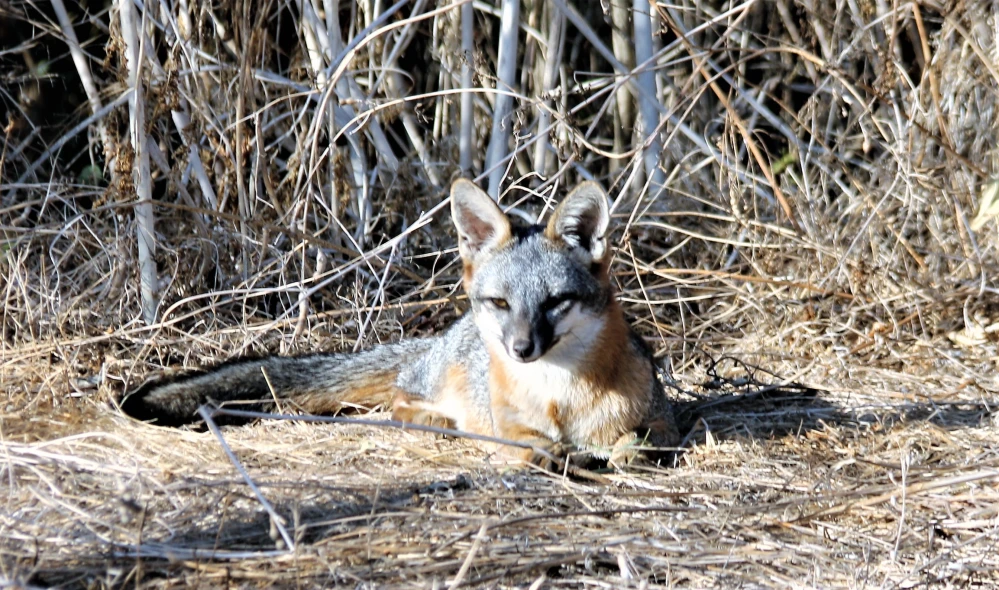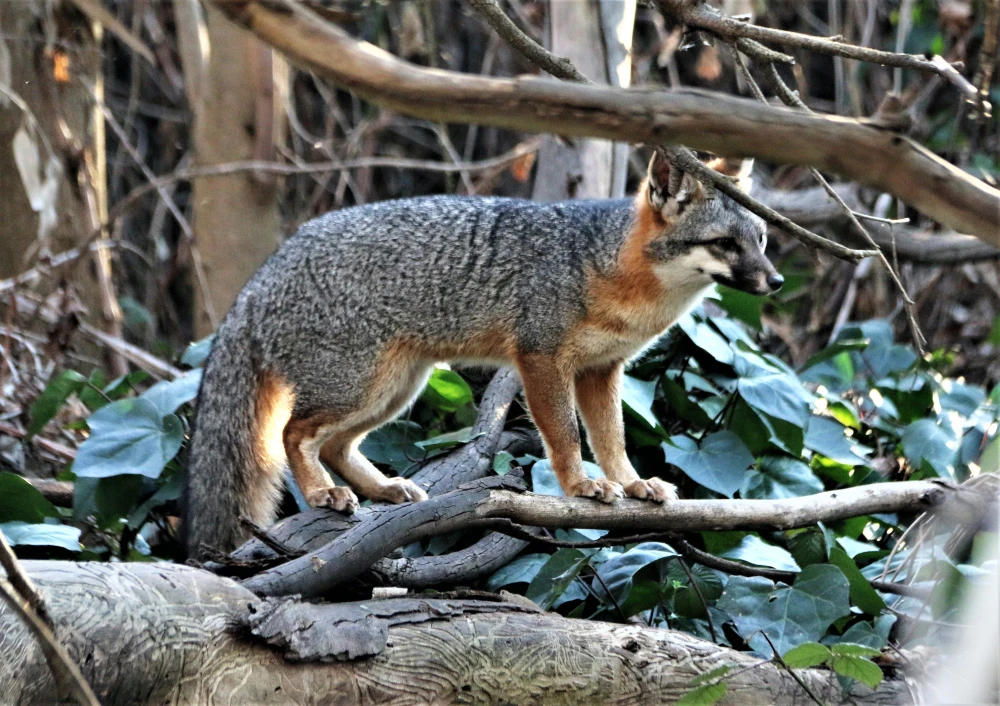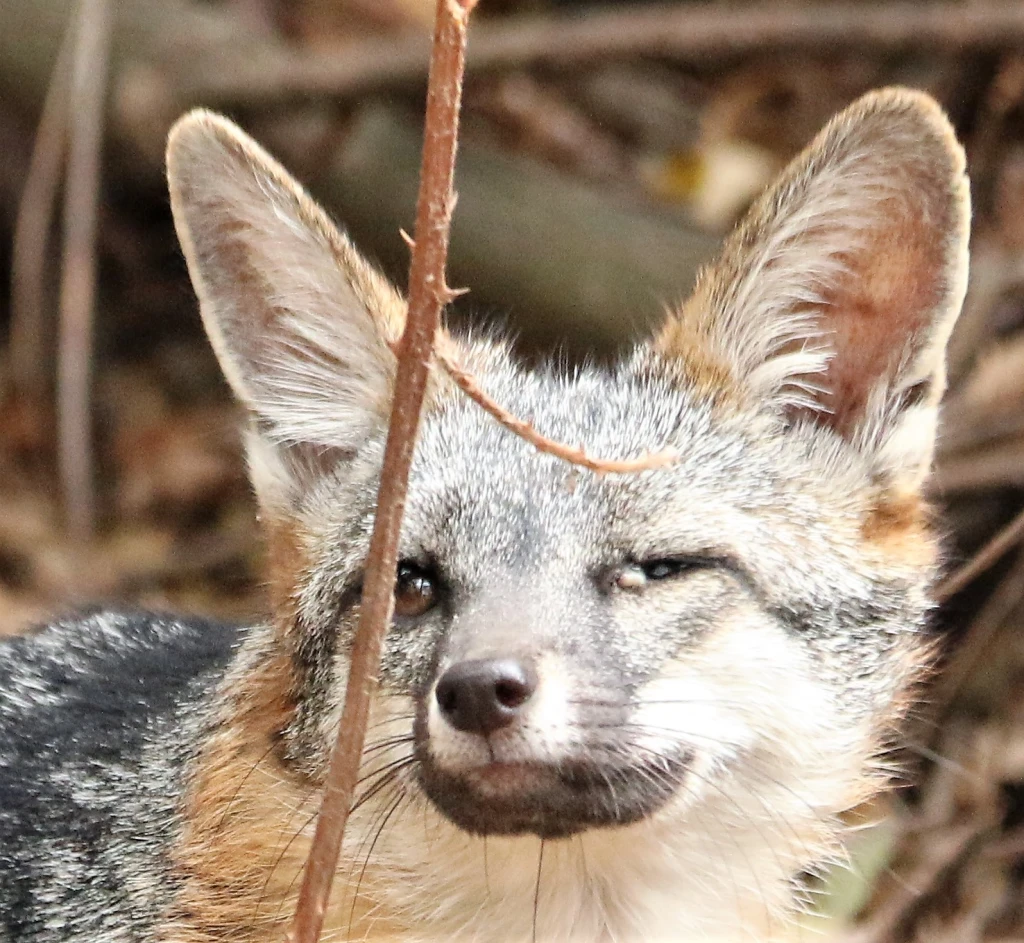Is It? A Gray Fox Tragedy May Be Brewing
by William C. Leikam
President, CEO & Co-founder, Urban Wildlife Research Project

On Saturday, October 10, 2020, at 3:31 PM I was down in the Big Clearing, in the heart of gray fox land, along Matadero Creek turning on the several Browning trail cameras that are located there. Usually at that time of day, both Laimos and Big Eyes are napping under the bushes nearby. Seldom do they make an appearance, but on that afternoon as I returned to the clearing from setting up cameras #10 and #3, I saw the tip of a fox’s tail vanish beneath the thicket.
Surprised, and as quietly as possible, I walked directly to the black walnut tree where my digital camera hung. I gave room to the foxes so that if they were going to emerge and that was by no means assured, I would be a comfortable distance away. I lifted the camera up to my chest so that I’d be ready to get rapid fire shots if one or both foxes came from the brush. I remained silent. I didn’t move. My attention focused under the huge branches of the fallen eucalyptus tree. Experience with these gray foxes has taught me patience, the kind that in such a situation borders on a meditation broken only when one or both foxes emerge.

One, two, five, seven minutes passed. No foxes. I broke my attention from under the fallen tree and looked off to my right. There in that patch of ivy sat Big Eyes watching me. Slowly, I lifted my camera and took several shots. She didn’t move. Then from my left side, I heard a snap and at that same instant, Big Eyes ears shifted right to under the tree and I knew that her mate Laimos was there. I turned toward him. As Laimos came into near full view, I took several shots of him carefully coming on out into the small clearing. I looked over to where I expected to see Big Eyes but she was gone.
I turned my attention back to Laimos, took numerous shots of him when as though simply materializing from under the fallen tree, Big Eyes joined her mate. I took shots of them side-by-side. By this time, they were comfortable enough with me taking pictures – they’d done similar things before – that they allowed me to take several steps away so that they had even more room. I expanded their comfort zone.
That afternoon I took 27 photos of the pair. As I moved through the still photos, tagging each as I went, everything that I looked at appeared to be normal gray fox until something caught my attention in one of the photos of Big Eyes. I asked myself, “What’s that?” I zoomed in on her left eye and my heart sank with understanding. I thought, “No, no, this can’t happen. Not again.” In the front corner of her eye was that puss-like drainage, that ugly ooze that can become so thick that it can blind them. That is one of the overt indicators of canine distemper. Big Eyes will die from it. How long she can hold on is anyone’s guess, but her immune system might hold off death for upward of a year or more.

Gray Foxes General Health
From my initial observations, Canine Distemper is present most likely in both gray foxes. It may be that the head shaking that I noted a couple of months ago is related to distemper although in the literature there is no mention of such.
Total Numbers of Gray Foxes in the Palo Alto Baylands Nature Preserve
As of October 2020, we have two adult gray foxes living in the Palo Alto Baylands Nature Preserve.
If you haven’t had a chance to read some of the articles that have been written about our study of gray fox behavior and our corridor work, click on these links as they will take you to the source: Bill Leikam – The Fox Guy, and Greg Kerekes & URWP
Section III
Gray Fox, Baylands Goals
Within the permit that allows the Urban Wildlife Research Project to conduct its study of the behavior of the gray fox at the Palo Alto Baylands Nature Preserve, the objectives covered area:
- Monitoring of urban gray fox Denning sites in Palo Alto Baylands.
This is being accomplished during the period when the gray foxes use a den site. It is one of the prime locations for gathering most of the behavioral data of the litter and for adults alike.
- Assessment of status and population trends of Baylands urban gray foxes
Since January 2019 a pair of resident gray foxes have claimed territory at the Palo Alto Baylands Nature Preserve.
- Identification of habitat features that promote the presence of urban gray foxes
After considering this and talking with people who know how to restore habitats, we need to assess what kinds of plants, including the Alkaline Salt Bush, would grow best along the edge of the saltwater channel and alongside the marsh. We need to grow a permanent habitat that contains the corridors and plant it as soon as possible. We’ll keep an eye on this as this is a critical link between the southern region of the Baylands and the northern region.
- Assessment of reproductive success and identification of factors that promote successful reproduction
Open up the pinch-point along Matadero Creek by developing thickets that link one area to another, instead of the present “islands”.
- Identification and assessment of possible dispersal travel routes.
Presently there can only be guesses as to dispersal travel routes. We intend to make this important question much more concrete when we attain our collaring/take/capture permit from the Department of Fish & Wildlife.



